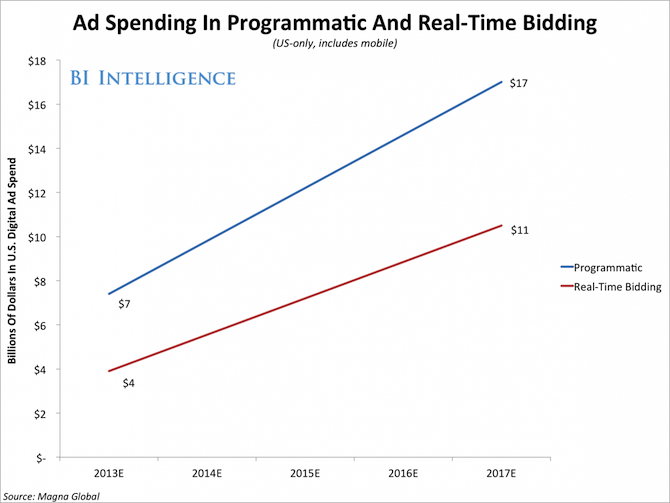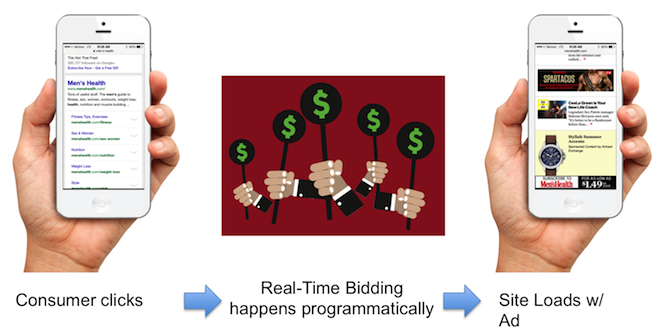From a marketing standpoint, buzzwords don’t get much more buzz than “Programmatic Ad Buying”—a process which has already transformed the ecosystem of online ads, and now seems likely to do the same for mobile. But, while it’s certainly tempting to jump on the programmatic band wagon, it’s important to filter out the hype and enthusiasm to discern what is actually currently possible on mobile—as opposed to what may be possible, some day.
What Exactly Are Programmatic Buying and Real-Time Bidding?
Programmatic ad buying simply refers to the automated purchasing of ads, circumventing the human-managed process of purchasing ad space via contracts or insertion orders. But this isn’t what’s gotten everyone talking. The real story centers around a subset of programmatic buying: Real-Time Bidding (RTB for short). RTB only accounts for $4 billion of the $7 billion annually spent on programmatic buying (Business Insider), but it has has come to dominate the conversation so completely that the terms “programmatic” and “RTB” are now used more or less interchangeably.

Image Courtesy of Business Insider
But what is real-time bidding? The main analogy everybody seems to be latching onto is “day-trading stocks”—incorporating algorithms and automation software so that we can keep up with a massively complex, constantly evolving system.
More specifically, real-time bidding is an automated process that happens within the fraction of a second between:
A. When a consumer clicks to open a site or app with available ad space
and
B. When the site or app actually loads on the consumer’s mobile device.
During this fraction of a second, real-time contextual information about the available ad space is sent from the supply side (publishers) to the demand side (brands, agencies, etc)—who then automatically do or do not place bids for the ad space.

Ad space is auctioned off and purchased programmatically within the 200 milliseconds it takes a page to load.
On a conceptual level, this system has two major benefits for mobile advertisers.
Obviously, it streamlines and simplifies a complicated workflow. As I talked about in an earlier post, mobile advertising is in dire need of software and services that reduce friction. There are hundreds of millions of unique eyeballs viewing tens of millions of sites and apps, on hundreds of different devices, across multiple screens.
In addition, RTB improves an advertiser’s all-important audience targeting capabilities by including a number of additional contextual parameters into the buying process. The publisher is no longer just saying, “I have available ad space on my app, which attracts X demographic.” They are now also saying “I have available space on my app, and it’s about to be viewed by a specific consumer, who meets a specific criteria, at a specific time of day, in a specific geographic area.”
This improvement in audience targeting builds on one of the core strengths of mobile advertising—its ability to reach anyone, anywhere, at anytime. And savvy mobile advertisers are already using RTB to concoct some crazy-but-brilliant strategies for focusing their campaigns.
Best of all, these real-time bidding parameters can be set to automatically adjust in real-time, so ad placements that underperform will be phased out to allow the campaign to focus only on buying space that is generating good results.
This video does a good job summing it all up:
The Problem With Programmatic Buying
While most agree that widespread adoption of programmatic buying and real-time bidding are the inevitable future of mobile advertising, there are some significant technical hurdles in place before the process can truly realize its potential. For one, the most valuable aspect of RTB on traditional ads—the highly-accurate re-targeting capability—doesn’t really exist yet for mobile devices.
A consumer viewing ads on a desktop is generating a lot more personal data for the advertiser to work with (specifically browsing history). Thus, RTB makes it possible for automotive advertisers to serve ads only to consumers who have been browsing automotive sites, and to serve different ads to different consumers based on what types of automotive sites they have been browsing (i.e. luxury, economy, etc).
But this sort of behavioral tracking is limited on mobile devices. And, while mobile consumers do deliver valuable contextual information (specifically their exact location) for advertisers, it’s not nearly as useful for real-time-bidding purposes as browsing history.
Also, mobile programmatic buying is largely limited to static banner ad placements, and has not been able to keep pace with the constant evolution of ever-more engaging mobile ad units. Native ads, video ads, and all the other rich media mobile ads poised to take over the market are still only available via direct partnerships with publishers or managed ad buys.
So, while programmatic buying and RTB streamlines the process in terms of scale, it has not yet replaced human management in terms of impact and engagement.
-
“You can buy millions and millions of small ads across websites and apps in programmatic channels right now,” says Eric Franchi, Co-Founder of Undertone. “The question is, do you have anything like the kind of impact you might have on TV, or on desktop PCs with rich media? Everybody talks about reach and targeting and audience. But if you don’t have impact, what good does it do?”
Nonetheless, programmatic is growing rapidly on mobile. A recent survey Millennial Media ran reported that 57% of advertisers are currently using programmatic buying on mobile, with 77% reporting that they plan to be buying programmatically by the end of 2014. And between now and then, the technology will no doubt improve:
-
“In 2014, programmatic buying of digital advertising inventory will expand beyond standard IAB ad units into premium placements and nontraditional display units, such as in-image, native, and content marketing,” said Ken Weiner, CTO of display advertising platform GumGum, in an interview with CMO.com.

